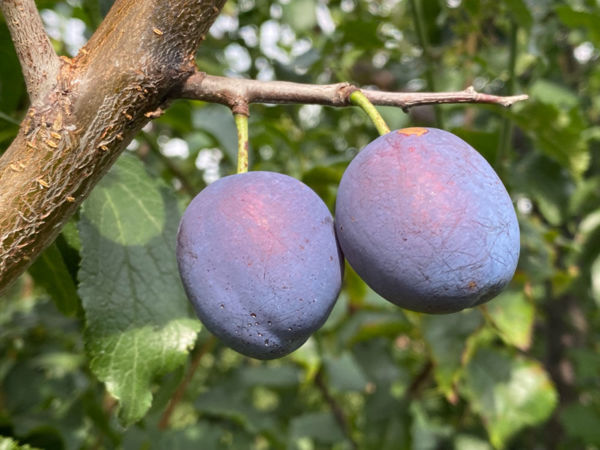An attractive, highly disease-resistant apple, ideal for organic growers.
Damson Plum Scionwood (Spring 2024)
An ancient plum used for baking, preserves, and slivovitz.
Damson trees are high vigor, productive, black-knot resistant, and adaptible to a broad range of soils and climates. They are self-fertile and do not require a pollenizer. The fruit ripens midseason, about ten days before Stanley.
From UC Davis: "This European plum is deciduous tree has dark bark and dark purple leaves, can grow to six meters in height. It is found in the wild in places that have a moist soil, along rivers and gullies. It is said that Damsons originally came from the area around Damascus in Syria, hence the name which allegedly derives from the Latin Prunum damascunum or "Plum of Damascus" and that they were introduced into England by the Romans where Damson skins where used in the manufacture of purple dye. However many of the wild plum cultivars colloquially referred to as "Damsons" seen growing wild may be hybrids (cross pollinations) of the native Blackthorn and Cherry Plum, Bullace or other cultivars. The Damson was introduced into the American colonies by English settlers before the American Revolution. It was regarded as thriving better in the continental United States than other European plum cultivars; many of the earliest references to European plums in American gardens concern the Damson. A favorite of early colonists, the tree has escaped from gardens and can be found growing wild in states such as Idaho. The skin of the Damson can have a very tart flavor, particularly when unripe (the term "damson" is often used to describe red wines with rich yet acidic plummy flavors)."
Volume Pricing
| Quantity | Damson Plum Scion |
|---|---|
| 1 | $12.00 |
| 2-5 | $7.00 |
| 6-10 | $6.00 |
| 11-99 | $5.00 |
| 100+ | $4.00 |
The Fruit
Fruit Type
Category: Plum
Subcategory:
European, Self-Fertile, Cold-Hardy
Fruit Uses & Storage
Uses: fresh eating, jam, baking, canning, freezing, jelly, sauce
Storage duration: one to three months (approximate, depending on storage conditions)
Fruit Appearance
Skin color: blue
Flesh color: yellow
Fruit Origins
Parentage: unknown
Origin: Syria
Introduced in:
Introduced by:
The Environment
Calendar & Geography
USDA zones: 4 - 8
Chill hours: 650
Ripening date: Aug 22 (approximate, in New York State) 10 days before Stanley
Diseases & Pests
glossary
Black Knot: Resistant
Pollination
Pollination Factors
glossary
Bloom group:
Is it self-fertile? N
Is it fertile? Y
Ploidy: Diploid
Pollination Partners
This table shows the first few results from a full search for pollenizers of Damson Plum. Please see our Pollenizer Search to run other queries and read how the application uses various factors. Also read more about fruit tree pollination.
| Tree | Currently in Stock |
|---|---|
| Early Italian Plum | 0 |
| Victoria Plum | 0 |
| Reine Claude Conducta Plum | 0 |
| Methley Plum | 0 |
| Longjohn Plum | 0 |
| Lavina Plum | 0 |
| Kenmore Plum | 0 |
| Green Gage Plum | 0 |
| Empress Plum | 0 |
| Castleton Plum | 0 |
| Yellow Egg Plum | 0 |
See all pollination matches for Damson Plum
Featured Products
A few things we're loving right now...
A full-flavored, freestone white peach.
One of America's oldest apples, good for storage, baking, and cider.
A widely-grown, large, yellow-fleshed nectarine.






















